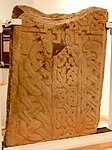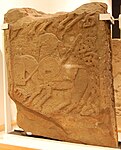Kirriemuir sculptured stones

56°38′39″N 2°53′21″W / 56.6441°N 2.8891°W The Kirriemuir Sculptured Stones are a series of Class II and III Pictish stones found in Kirriemuir, Angus, Scotland. Their existence points to Kirriemuir being an important ecclesiastical centre in the late first millennium AD.
Location
[edit]The stones were found in the grounds of Kirriemuir Kirk grid reference NO38955448. The stones are now on display at the Meffan Institute in Forfar, Angus.
Description
[edit]Kirriemuir 1
[edit]The slab is carved on both faces in relief and, as it bears Pictish symbols, it falls into John Romilly Allen and Joseph Anderson's classification system as a class II stone.[1][2] The stone bears a number of figural representations and a mirror and comb symbol. The figures have been identified as Saints Anthony and Paul.[3]
The stone is one of the latest to include pictish symbols and can be dated with confidence to the late 9th/early 10th century.[4]
Kirriemuir 2
[edit]Cross slab carved on both faces in relief. It too contains Pictish symbols and falls into John Romilly Allen and Joseph Anderson's classification system as a class II stone.[1]
References
[edit]- ^ a b Allen, J. Romilly; Anderson, J. (1903), Early Christian Monuments of Scotland, vol. 1, Balgavies, Angus: Pinkfoot Press (1993 facsimile), pp. 242–245
- ^ Allen, J. Romilly (1890), "Preliminary list of sculptured stones older than A.D. 1100, with symbols and Celtic ornament, in Scotland" (PDF), Proceedings of the Society of Antiquaries of Scotland, 24: 510–525, retrieved 29 November 2010
- ^ "Site record for Kirriemuir 1 stone", Royal Commission on the Ancient and Historic Monuments of Scotland. Canmore database., retrieved 6 December 2010
- ^ Laing, Lloyd R. (2000), "How late were Pictish symbols employed" (PDF), Proceedings of the Society of Antiquaries of Scotland, 130: 637–650, retrieved 6 December 2010






